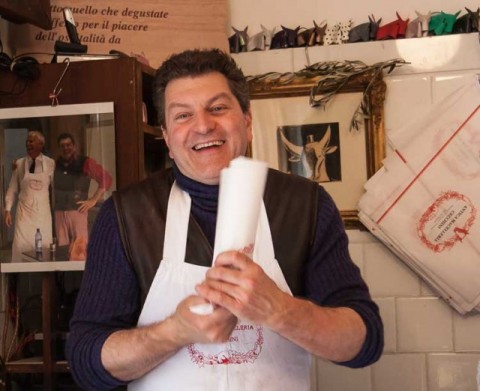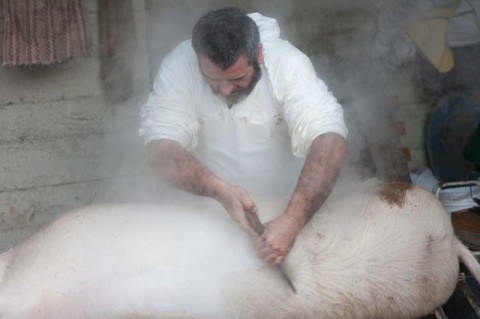Italian Butchery: It's Different Over There
We Americans live in oddly mechanical times. In front of the supermarket meat counter we are connected to "the butcher" via a button whose croaking ring urges someone wrapped in a white lab coat to come "up front" after he turns off the noisy, 300 hp industrial saw he's been using to cut the lamb chops apart.
Seldom, though, do people ring. Instead they pick among the Styrofoam trays stacked before them, each stuffed with ground and sawed-apart meat. Each category of meat comes in packages that are all the same weight. They have been packed sometime during the last week or two. Little absorptive diapers sop up the blood and other juices as they leak from the aging muscle, ensuring you pay for every drop of ooze made invisible. Labels warn the shopper to cook the hell out of the meat, because it has undefined poisonous qualities.
You, the shopper are alone with your meaty thoughts. Forlorn. Still, the collective you will buy lots of meat. The collective you will eat too much of it. The collective other will wag a disapproving finger at you because you are single-handedly destroying the universe with your infernal meat eating.
All these things are generally not true in my little corner of rural Tuscany. "It is a good thing," I hear you say, "because you were getting just a bit tedious."
Butchery can be quite a social occasion in Tuscany. A butcher, Macellaio, can be a celebrity. Surely you have heard of Dario Cecchini, reciter of Dante and meat cutter to the stars. He runs the family butcher shop or macelleria called L'Antica Macelleria Cecchini in Panzano, a little town in Chianti territory. If you have nothing to do on a weekend during your vacation in Italy's largest region, perhaps you should stop in. There is likely to be a party going on. Music, tasty bits, a poetry-spouting butcher leaning over a wooden block knifing slabs of beef. You don't need a map or a reservation. Just go to the little village and you'll find the party, trust me.

Yep, in Italy good food is part of the culture, like the music and the poetry. An animal has given his life for you--celebrate the sacrifice!
You know what? An animal killed humanely tastes much better! Yes, that Adrenalin saturating the muscles of every frightened animal in the slaughter house kill line is spoiling the meat even before the deed is done. Also, a pig eating what it wants to eat (acorns!) produces fat that is much better for you than a pig fed nothing but corn or industrial animal feed. The old artisan ways were best, scientifically speaking.
Celebrate the butchers who carefully source their meat! You can do that in Italy. I've even come across butchers who can tell you which local shepherd is responsible for the lamb chops you see behind the glass counter.
Rent a place in Italy and try getting some meat at a butcher shop. It's better than streaming your favorite television show.
I've never been in favor of cutting up a carcass, putting the bits in trays, and letting everything stew together until it goes bad--or someone buys it. There are better ways.
I remember needing a specific cut of pork for a meal I was cooking for an archaeological crew in Sardinia. I had to study up before going to the local butcher shop because the cut was different than an American cut. So I found a chart, practiced the Italian necessary to make sure the butcher could give me what I wanted, and eventually trundled off to the shop.
As I stood mesmerized before the gleaming case with all the muscles and chickens and things labeled with a price, the butcher came out and we did our greetings. Then came the hard part. I told him what I wanted. He scratched his chin. He looked around. He shook his head.
Then he gave a soft sigh and shuffled off to the back. I had no idea what he was up to.
He returned with half a pig slung over his back.
"An, um, no!" I stuttered loudly. I had a reasonable idea of my competency in the Italian language, and it worried me that I might end up having to pay for half of a pig.
He let the carcass slide off onto the stainless steel table. "Aspetta," he implored. Wait.
He selected a knife, honed the edge, and began to dig into the carcass. Each bit he cut off was thrown with a gentle arc into the back of the meat case. Early on I thought each bit might be for me.
It turns out my bit was in the center of the pig. After liberating it, he held it up and grinned like it was a crown for some cute princess who lived in the castle and only ate meat on Sundays.
"Grazie!" I said. I was relieved. The cut was exactly how I envisioned it, but better. It didn't cost nearly what half a pig might cost.
And my oh my was it good! There is nothing like a freshly cut roast from a well-hung pig, I can tell you. Not everything that is good about Italian cuisine comes from cooking and knowing what spices to enhance a cut of meat. Raw materials count.
And finally, did you know that Italians can raise a couple animals for their own use? This works out best in rural areas because keeping a pig in your city apartment can get your neighbor's dander up. I've seen it in my little chosen village. Here is how the best salami in the Tuscany nobody knows about starts:
 |
Steamy. this pig debristling, isn't it? Gritty. Full of life. Like Italy behind the curtain. Be not afraid.
Celebrate!

